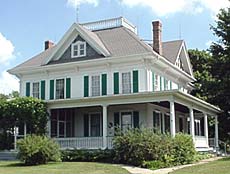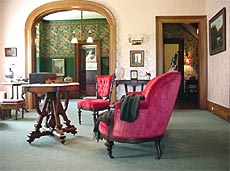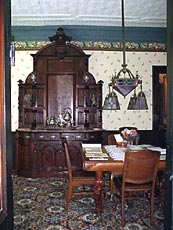|
Features,
Animals
for Adoption,
Out
and About Travel
News Elsewhere (fresh daily
from the Web) Home and
Garden News Elsewhere (fresh
daily from the Web)
|
|
Features
|
|
U
of I Extension offers timely horticulture class
[SEPT.
4, 2001] Dave
Robson will teach "Selection, Planting and Care of Hardy
Bulbs" at the Extension office on Tuesday, Sept. 18, at 10 a.m.
Robson is from the Extension center in Springfield. The class is
open to all and there is no charge.
Reservations
are requested, as the class will be canceled if the minimum of 10
participants is not met. Please call 732-8289 to reserve a place.
If
you need a reasonable accommodation to participate in the program,
please contact John Fulton, unit leader of Logan County Extension.
[Click
here for the U of I Extension program schedule for the upcoming
year.]
|
|
|
Small
outbreak of deadly parvovirus
[AUG.
24, 2001] Puppy
a little puny? If you have a pup that’s acting quiet, not
puppylike, you may want to have it checked by your veterinarian.
Best Friends Animal Hospital has seen an increased number of cases
of the deadly parvovirus this year.
|
|
Veterinarians
Lara Borgerson and Ron Pierce treated five cases just this week in
what appears to be a small outbreak. Lincoln Animal Hospital
reported that they have not seen much increase, though they saw a
particular outbreak earlier this year that was associated with a
litter from Springfield.
The
highly communicable disease is most often seen in the spring of the
year when everyone starts getting out and going places more often.
Your dog does not need to go to the source of the virus to pick it
up. The virus could easily come to him or her. It is spread by
contaminated feces. Anyone could unknowingly track the invisible
virus into the home or yard where your puppy lives, and he or she
could pick it up. The virus is long-living and highly virulent. It
can be killed on contaminated surfaces with a 10 percent bleach
solution.
The
virus affects dogs between the ages of a few weeks up to 8 months.
It is most often seen in 3-, 4- and 5-month-olds. The incubation
period (the time when the virus is in the body before symptoms show)
for the virus is one week.
[to top of second column in
this article]
|
It
requires hospitalization of two days to about a week for the patient
to recover. If not caught early enough and treated, up to 70 percent
of puppies die from it.
There
is a test for parvo.
Symptoms
of parvovirus include:
•
Depressed (quiet, not much energy)
•
Vomiting
•
Bloody diarrheas
The
best advice from the veterinarian is to make sure your dog’s
vaccinations and boosters are kept up to date and to watch your dog’s
behavior. Puppies need a series of four vaccinations up to 5 months
of age. If your dog seems a little under the weather or is just not
acting like himself or herself, contact your veterinarian.
You
can find more information at these websites:
http://www.animalclinic.com/parvo.htm
http://www.peteducation.com/dogs/
parvovirus.htm
[Jan
Youngquist]
|
|
|
Animals
for Adoption
|
|
These animals and
more are available to good homes from the Logan County Animal
Control at 1515 N. Kickapoo, phone 735-3232.
Fees for animal
adoption: dogs, $60/male, $65/female; cats, $35/male, $44/female.
The fees include neutering and spaying.
Logan County Animal
Control's hours of operation:
Sunday – closed
Monday –
8 a.m. - 5 p.m.
Tuesday –
8 a.m. - 5 p.m.
Wednesday –
8 a.m. - 5 p.m.
Thursday –
8 a.m. - 5 p.m.
Friday –
8 a.m. - 3 p.m.
Saturday –
closed
Warden: Sheila Farmer
Assistant: Michelle Mote
In-house veterinarian: Dr. Lester Thompson
|
DOGS
Big to
little, most these dogs will make wonderful lifelong companions when
you take them home and provide solid, steady training, grooming and
general care. Get educated about what you choose. If you give them
the time and care they need, you will be rewarded with much more
than you gave them. They are entertaining, fun, comforting, and will
lift you up for days on end.
Be prepared to take the necessary time when you bring home a
puppy, kitten, dog, cat or any other pet, and you will be blessed.
[Logan
County Animal Control is thankful for pet supplies donated by
individuals and Wal-Mart.]
|
|
|
|
Ten reasons to adopt a
shelter dog
1.
I'll bring out your
playful side!
2.
I'll lend an ear to
your troubles.
3.
I'll keep you
fit and trim.
4.
We'll look out for each other.
5.
We'll sniff
out fun together!
6.
I'll keep you
right on schedule.
7.
I'll love you
with all my heart.
8.
We'll have a
tail-waggin' good time!
9.
We'll snuggle
on a quiet evening.
10.
We'll be
best friends always.
|
|
|
CATS
[Logan
County Animal Control is thankful for pet supplies donated by
individuals and Wal-Mart.]
|
|
Warden
Sheila Farmer and her assistant, Michelle Mote, look forward
to assisting you. |
| In
the cat section there are a number of wonderful cats to
choose from. There are a variety of colors and sizes.
Farm
cats available for free!
|
|
|

[The
"three musketeers" need a home.
The two females and one male are looking for some mice
to chase and would love a new home on a farm.]
|
|
|
|
|
Tell
a friend about
Lincoln Daily
News.com |
Our
staff offers more than 25 years of experience in the
automotive industry.
Greyhound
Lube At
the corner of Woodlawn and Business 55 No
Appointments Necessary |
Advertise
your
Garage
Sale in Lincolndailynews.com
--
It's FREE! --
Click
here |
|
|
|
|
|

|
|
Part
2
Funk home
was both
comfortable and impressive
[SEPT.
10, 2001]
When
LaFayette Funk brought his bride Elizabeth home to Illinois, he
presented her with his wedding gift — the spacious, graceful
13-room country home near Shirley, south of Bloomington, that is
today the Funk Prairie Home. He built it himself with lumber from
the family land at Funks Grove, just down the road.
|
|
[Click
here for Part 1]
When
he and Elizabeth moved in, in January of 1865, the house was not
completely finished inside. It took them 10 years to complete the
home and furnish it the way they wanted.
Although
first and foremost the Prairie Home was a home, LaFayette, like his
father, was a public person, and he often entertained visitors,
perhaps the governor or another state official, perhaps farmers from
the United States and other countries who came to see the model farm
on the Illinois prairie. The Funks were so far ahead of their time
in farming practices, people came from far away to learn from them,
according to Bill Case, guide and caretaker of the home.

LaFayette
followed in his father’s footsteps as a "cattle king"
and was a founder and director of the Chicago Union Stockyards. Like
his father, too, he was both a state representative and a state
senator. He was prominent in Illinois agriculture, serving for
nearly 25 years on the State Agricultural Board. This board worked
for laws which would benefit farmers, helped plan courses of study
at the University of Illinois agricultural college, and took part in
planning and staging the 1983 World’s Fair in Chicago.
So
LaFayette and Elizabeth’s home was both comfortable and
impressive. Guests entering the front hall saw a stamped tin ceiling
and a fine large hall tree, complete with mirror. The hall tree is
one of six pieces made by a carpenter "out east," where
the best furniture was made at that time.
LaFayette
and Elizabeth had gone to the United States Centennial in
Philadelphia in 1876, where they saw furniture that was made as a
gift for President Ulysses S. Grant. They had been saving money for
10 years to buy the kind of wood pieces they wanted, so they found
the firm that made Grant’s furniture and ordered six pieces for
their home on the prairie. Grant’s furniture is now in Blair House
in Washington, D.C., while LaFayette and Elizabeth’s furniture is
still in the Prairie Home, along with most of the other pieces they
purchased.

All
six pieces have a rosewood base, with burled walnut and, on most
pieces, bird’s eye maple veneer. Superb handiwork and detailed
wood carving make them still impressive 125 years later. Downstairs,
along with the hall tree, is a massive desk-bookcase, sometimes
called a "secretary," which sits in the library next to
the living room. A 10½-foot sideboard dominates the dining room.
The other three pieces are in the guest bedroom upstairs.
In the
parlor, just off the front hall, hang portraits of Isaac and
Cassandra, LaFayette’s parents. Here, too, is a Chickering square
grand piano, made by the famous Boston firm and bought by the Funks
in Chicago. Although most furniture was shipped by railroad at that
time, this piano was brought to the Funk home by oxcart, making the
trip from Chicago in just three days.

The
parlor, always the most elegant and least used room in a house of
that time, has a fine Italian marble fireplace (even though the home
had hot-water central heating), also a floor-to-ceiling pier glass
between two windows. The pier glass, Case explains, was called that
not because people "peer" into it, but because it came by
ship from Europe and had to be picked up at the dock or
"pier" when it was unloaded.
The
living room, separated from the parlor by a golden oak archway, was
the place for family and close friends to gather. Although this
room, too, has an Italian marble fireplace, the furniture is not so
impressive, just what people of that time could buy through the
Sears, Roebuck catalog.

[to top of second column in
this section]
|

The
highlight of the living room tour is the 1913 Victrola. Case winds
it up and puts on a record to play for visitors, perhaps the song
"To Any Girl," recorded in 1904 by Alexander Campbell and
Henry Burr. Although recording techniques at that time did not pick
up bass sounds nearly as well as they do today, the music still
sounds amazingly good. Perhaps that is because of the bamboo needles
that play the thick, old 78 rpm records. The Funks always thought
ahead, so along with a huge supply of these bamboo needles, the
Funks also had a needle sharpener. Those needles will last another
hundred years, Case says.
Elizabeth,
a talented musician, must also have loved the Swiss music box that
sits on a small table in the living room. Case winds it up so
visitors can hear one of the five tunes it can play.

Off
the living room is the library, with the big secretary. Accessible
from both the library and the dining room was a real luxury for an
early farm family — an indoor bathroom with a zinc-lined tub and a
toilet. Water was pumped into a tank in the attic to operate the
gravity-flush toilet.
The
dining room could seat 16 comfortably for dinner. The big sideboard
and the bay window are focal points in the room.

Not
only most of the furniture but even some of the houseplants are
original. On the plant stand in the bay window is Elizabeth’s
Christmas cactus, now 125 years old, which she brought back from the
United States Centennial celebration in Philadelphia in 1876. A
cutting from a night-blooming cereus, also 125 years old, is on the
plant stand as well.
On the
table is Volume I of the Funk-Stubblefield family tree. This book
has 800 pages, and Volume II is in the works.

Above
the table hangs an electric light fixture that looks as if it might
have been designed by Frank Lloyd Wright, or at least someone
well-known in the Arts and Craft movement. This, and the kitchen,
demonstrate that members of the Funk family possessed a wide array
of talents.
LaFayette
and Elizabeth had only three sons, one of whom lived just a few
years. The oldest, Eugene Duncan Funk, usually known as E.D., became
a noted seedsman who pioneered the use of hybrid corn. The youngest,
Marquis DeLoss, branched off in a new direction. Sent to the
University of Illinois to study farming, DeLoss instead signed up
for courses in the new science of electricity. At the U of I he
built an internal combustion engine and became the university
president’s chauffeur.
When he came home again,
he put his talents to use in the Prairie Home. Not only did he
design and build the light fixture in the dining room, he provided
his home with electrical appliances that most people didn’t dream
existed, let alone hope to own. In 1910, the farm had so many
electric lights journalists called it "The City on the
Prairie." DeLoss was "light years ahead of his time,"
Case explains, because the city of Bloomington didn’t have
electric lights for another five years, and ordinary rural people
didn’t have electricity for another 15 years.
(To be continued)
(For a tour of the Funk
Prairie Home and Gem and Mineral Museums, call (309) 827-6792. Tours
are available Tuesdays through Saturdays from 9 a.m. to 4 p.m. March
through December. Tours range from individuals to groups of 50 and
are free of charge.)
[Joan
Crabb]

|
|
|
Part
1
Funk
Prairie Home tells story of prominent, colorful central Illinois
family
[SEPT.
8, 2001]
Not
every tourist attraction makes you want to pull up a chair and just
sit awhile on its front porch, or perhaps wander through its lawn
and gardens. But the Funk Prairie Home, a little gem of a museum
near Shirley, south of Bloomington, does just that.
|
|
This
inviting country home also gives visitors a pleasant and painless
history lesson, a look at a prominent rural family whose
accomplishments are interwoven with the story of our state and
nation.
And if
that isn’t enough, part of this gem of a museum includes a museum
of gems, room after room of cut and uncut gems and minerals from all
over the world. Another section of the museum, still a work in
progress, tells the story of the Funk Brothers Seed Company, which
became a major producer of hybrid corn in the United States and
abroad.

Perhaps
the most important feature of the Funk Prairie Home is that it still
keeps the feeling of the comfortable, welcoming place it was in the
days when the man who built it, Lafayette Funk, entertained
important political and business leaders there. This impression is
helped along by the tour given by guide and caretaker Bill Case, who
somehow makes you feel you are one of those honored guests who were
entertained by LaFayette and his wife Elizabeth.
"The
Funks knew what hospitality was and how to make you feel at
home," Case says. "Our mission, different from that in the
grand showplace homes like the David Davis mansion in Bloomington,
is to educate people about the Funk family and life back when they
were living here.
"We
want people to feel like they’ve been in a home, not in a museum.
We want them to feel they’ve been a part of what they are seeing.
The tour is about the people who lived here, not just about the
stuff you see here. History isn’t just stuff."
The
"stuff" in the 13-room house, however, reflects the
interesting lives of the Funk family, as does the house itself.
Built in 1863-64, it was a wedding present for Elizabeth Paullin of
Ohio, whom LaFayette met and fell in love with while in college.

Although
LaFayette insisted upon bringing his bride to a comfortable and
spacious home, he himself was born and spent his early years in a
log cabin. His father, Isaac Funk, a man of German descent who come
to Illinois from Ohio, and his mother, Cassandra Sharp of the Fort
Clark area (now Peoria), homesteaded on the McLean County prairie in
a one-room cabin located at what is now the Funk’s Grove rest stop
along Interstate 55.
Isaac
and Cassandra had 10 children, nine of whom lived to the age of 50
or more, unusual at that time. LaFayette, the fifth child, was born
in 1834 and died in 1919, when he was 85, two years after he broke a
hip cutting ice on a pond. In those times, a broken hip was usually
a death sentence, but LaFayette didn’t think he could die right
away because he still had important work to do.

LaFayette
had incredible energy, Case says. He was 6 feet 3 inches tall, built
like a linebacker, and he would leap out of bed at 4 a.m. because he
couldn’t wait to get to work on his farm.
Still,
he probably wasn’t a match for his father, "iron man"
Isaac Funk, described as "tornadic and dynamic, 6 feet 2 inches
of solid muscle." Isaac broke the prairie sod to plant corn,
raised cattle and hogs and drove them to market, sometimes for
hundreds of miles. He was able to sit in the saddle for as long as
three days without sleep while driving livestock to market.
[to top of second column in
this section]
|

Cassandra
was no fragile prairie flower, either. It was said she could ride
and drive cattle better than any other woman in the area. Most of
her 10 children were born in one of two log cabins, the first one
measuring only 12 by 14 feet —
not as big as one of the rooms in the Prairie Home.
The Isaac Funk family did not move into its first frame home until
1841.
A
Methodist, Isaac was an ardent abolitionist who strongly supported
Abraham Lincoln for president. Lincoln is said to have called him
the most honest and forthright man he ever knew. Isaac, himself a
good hand with an ax, coined the name "railsplitter" for
Lincoln’s campaign.
Before
he died, Isaac accumulated 25,000 acres of fine Illinois land. He
became known as the "cattle king" because of the number of
animals he raised and took to market and his advanced methods of
breeding and raising quality livestock.

He
also found time to serve for a number of years in the Illinois House
of Representatives and in 1862 was appointed to the Illinois Senate
to complete the unexpired term of Richard Oglesby. He was re-elected
in 1864 and attended a session of the Senate on Jan. 14, 1865, just
16 days before his death. (He died on Jan. 30, and Cassandra
followed him three hours later.)
Isaac
was a firm friend of the Union and an enemy of the
"Copperheads," Northerners who sympathized with the South
during the Civil War. His famous Copperhead speech, given in 1863,
was widely reported in the national press and read to Union soldiers
all over the country. Isaac pulled no punches, calling them traitors
and secessionists who deserved hanging, and offering to fight with
any one of them in any manner they chose. He was 65 years old at the
time, but still so strong that when he spoke people could hear him a
block away, and when he pounded his fist on the table, the inkstand
bounded half a dozen inches into the air.
Like
his father, LaFayette was a man of many accomplishments. His full
name was Marquis De LaFayette Funk, in honor of the French general
who helped George Washington in the Revolutionary War.
He was
the first of Isaac’s sons to go to college, and he went to Ohio
Wesleyan because it had a program for scientific farming. (Isaac was
one of the founders of Illinois Wesleyan College in Bloomington.)
There LaFayette met Elizabeth, a gifted musician who lived in a
house that had been a station on the underground railroad.

They became engaged, and
he promised to come for her as soon as he built a home for her to
live in. She agreed to wait, though she probably didn’t think it
would take as long as 2½ years. But when she did get to Illinois,
she found a gracious, comfortable 13-room home, surrounded by rich
farmland, where she spent the rest of her life.
(To be continued)
[Joan
Crabb]

[Click
here for Part 2]
|
|
Back
to top |
News
| Sports
| Business
| Rural
Review | Teaching
& Learning | Home
and Family | Tourism
| Obituaries
Community | Perspectives | Law
& Courts | Leisure Time | Spiritual
Life | Health
& Fitness | Letters
to the Editor
|
|

